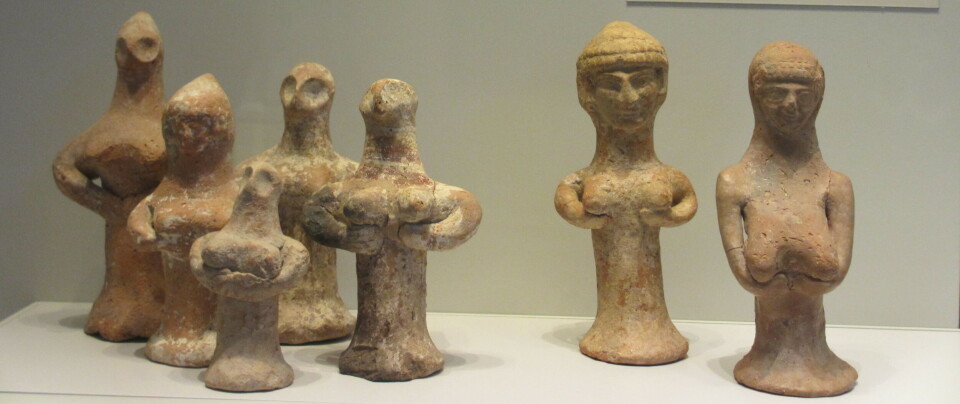God Originally Had a Wife
“We who study the Old Testament are very aware that God has a past. The religion described in these texts comes from somewhere,” says Anne Katrine de Hemmer Gudme.
She is a professor at the University of Oslo's Faculty of Theology.
It all starts in a turbulent area in the Middle East.
It begins with people losing their land. Before, they could go to the temples, where they could see and learn about the gods and how to worship them. When they no longer had access to the temples, texts became more important, like a kind of instruction manual.
“Sacred texts become the centre of religion, but this did not happen right away,” Gudme says.
Two vulnerable kingdoms
Nearly 3,000 years ago, two small kingdoms were located where Israel and Palestine are today. They were neither large nor important, but were strategically located on an important trade route.
This resulted in other kingdoms constantly targeting them. They were besieged and conquered. In the year 722 BCE, Israel, one of the kingdoms, falls. 130 years later, Judah, the other, falls. The people flee.
These peoples had several gods, whom they worshiped and sacrificed to in their temples. Yahweh was one of them. Today he is called God.
Neither he nor the other gods protected their people from their enemies.
“These people were in the midst of a national, collective trauma. They had experienced total defeat. They then begin to produce texts for what later becomes the Old Testament. Think of it as a form of crisis management,” Gudme says.
Preserve and promote Yahweh
They keep their god, Yahweh, even though he did not protect them from occupation and exile. Maybe it was their fault that they were not good enough worshipers?
“But now they change the religion. Previously they had several gods, where Yahweh was one of them. Now he becomes the most important,” Gudme says.
Only a few scholars could write at the time.
“So it's among this elite that we find the authors of the Old Testament. It's not unusual for the upper class to set the premises,” she says.
Their message was that from now on, Yahweh would be the only god they would worship.
That's why they use a lot of space in their writings to warn against the other gods.

Believed in other gods
“In the beginning, it was more monolatry than monotheism,” says Gudme.
Monolatry means that the authors of the Old Testament recognised that other gods existed, but they encouraged people to worship only one of them, Yahweh.
“Later on, over the centuries, they move to the belief that there is only one god, Yahweh or God as we call him today,” Gudme says.
On the path from Yahweh as one of several gods to the only god, the other gods are harassed and declared powerless.
“These gods slowly disappear, because many were satisfied with them and still worshiped them. They didn't bother to listen to some grumpy men who said that Yahweh was the only god,” she says.
Asherah was one of the gods that the authors of the Old Testament warn against.
Yahweh and his Asherah
“The way Asherah is treated in the scriptures is deeply fascinating. She is vilified and demeaned. She is linked to a Syrian god and not mentioned in connection with Yahweh,” Gudme says.
But Asherah was closer to Yahweh than the authors of the Old Testament would admit. Gudme, like other Bible scholars, believes she may have been Yahweh's wife.
“Inscriptions have been found from that time that place Asherah side by side with Yahweh, that she is Yahweh's Asherah,” she says.

There are not many inscriptions that point to Asherah and Yahweh as a couple, but they have been found in several places in the area.
One of them is from Sinai, Egypt – see the image above. Another of the finds was made in Jerusalem. Two divine figures stand close together on a fragment of a pot. Researchers believe it is Yahweh and Asherah.
Fierce propaganda against Asherah
In addition to inscriptions, researchers have found a number of small female ceramic figurines. Most agree that these represent Asherah.

“We don't know much about Asherah. She is often associated with love, passion, and war, but it's not certain that these were actually her domains,” says Gudme.
The authors of the Old Testament were active in their propaganda against Asherah. They equate her with a well-known villain, the false god Ba'al. They encourage people to destroy symbols of Asherah.
‘Tear down their altars, smash their sacred pillars, cut down their Asherah poles, and burn their idols in the fire,’ it says in Deuteronomy, chapter 7, verse 5.
“They are eager to tell people not to worship Asherah, also called the Queen of Heaven. This wouldn't have been necessary if they thought she didn't exist,” Gudme says.
Losing ground over time
People protest. They do not want to give up their goddess: ‘But ever since we stopped burning incense to the Queen of Heaven and pouring out drink offerings to her, we have had nothing and have been perishing by sword and famine’ (Jeremiah, chapter 44, verse 18). Because after they stopped worshiping the goddess, they lost everything. War and famine took their lives.
But time passes. The texts multiply, and the existence of other gods is toned down. Now the authors put more emphasis on the fact that Yahweh is the only god that exists.
And he gains more and more followers.
“Some events make the texts even more important, such as the Romans destroying the temple in Jerusalem around the year 70 BCE. By then, the scriptures had absolute authority,” Gudme says.
The worshipers of Yahweh have succeeded.
Triumphs in three religions
“Many other religions have also had collections of scriptures, but the texts that become the Old Testament have had an exceptional history of being handed down through the centuries,” says Gudme.
“They become sacred texts in Judaism. They are picked up by the first Christians. And they appear as stories in the Quran,” she says
Cato Gulaker is head of studies and an associate professor at Ansgar University College, which is owned by the Mission Covenant Church of Norway.
Gulaker confirms that the scholarly approach to the Bible widely accepts that God's identity changed when scripture became more important than land during the exile.
“Yahweh was a local storm god in the Late Bronze Age. To put it simply, many small gods were merged into the big god,” he says.
This was not popular in some Christian circles.
Feelings run high among students
“There are some who would prefer this not to be the case, and who try to challenge this information,” says Gulaker.
God's past is not widely known – not even among the students who study theology at Ansgar University College.
"They encounter their childhood faith, which is a lightweight, against the heavy academic study of the texts in the Old Testament. The students go through a maturation process," says Gulaker.
Some students find this process more painful than others, but the education focuses on the biblical texts.
“This is not about theory or archaeology. We stick closely to the biblical texts. Students learn Hebrew and Greek and about what has been lost in the translations. Then they have to make up their own minds,” Gulaker says.
He mentions that feelings can run high in the classroom when they go through how God changed over the 1,000 years that the Old Testament was written.

Does not go over well in church
“The Old Testament contains stories of God being jealous, irritated, and taking evening walks, and stories where God is omniscient and omnipotent,” Gulaker says.
He clarifies that the teaching emphasises studies of texts about God that have evolved over time, represented by what people have thought and written about him.
“God himself is not available as a research subject,” he says.
Most students end up with a less rigid view of the Bible, and more knowledge of what the texts actually say.
"Yet, they are left with the idea that the ancient scriptures have something to say to us today," says Gulaker.
But you won't hear the priest talking about God's past or the slightly irritated god.
“Much of this does not go over well during the Sunday service. But I teach about this in Bible classes for people who want to know more,” he says.
Skilled god or skilled helpers?
So the question is whether Yahweh prevailed over Asherah and the other gods because he was a stronger god or because he had more skilled people on his side.
“It depends on whether you look at this historically or religiously. Yahweh essentially had his own advertising agency and copywriters. He was supported by people who had power in society, and who managed to recruit more people,” Gudme says.
She believes she knows what the authors of the Old Testament would have answered:
“They would answer both ways: We have the best god, and the best god has us, who are the best worshipers,” she says.
But it could have gone differently.
“It was not a given that Yahweh would survive the other gods, but sometimes coincidences and a bit of luck lead to events that change the world,” Gudme says.
———
Translated by Nancy Bazilchuk